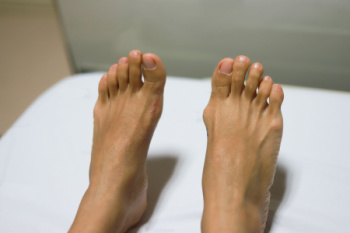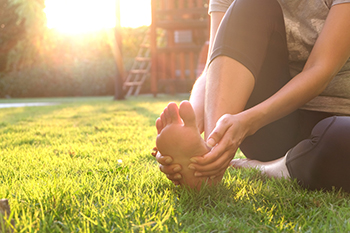Connect With Us
Blog
Items filtered by date: May 2024
Wounds That Don't Heal Need to Be Checked
The Impact of Tinea Pedis

Tinea pedis, commonly known as athlete's foot, extends its reach far beyond the realm of athletes. This fungal infection thrives in warm, moist environments, making anyone susceptible, regardless of their athletic pursuits. Individuals who frequent communal spaces like gyms, swimming pools, or shared showers are at highest risk. Preventive measures play an important role in warding off this uncomfortable infection. Keeping feet clean and dry, especially between toes, helps create an unsatisfactory environment for fungi to flourish. Wearing breathable footwear made of natural materials and changing socks regularly can minimize moisture buildup. Avoiding walking barefoot in public areas and using antifungal powders or sprays as a preventive measure can further reduce the risk of infection. Athlete’s foot can be treated by a podiatrist. If you notice signs of this uncomfortable foot condition, it is strongly suggested that you visit this type of doctor who can prescribe medication for effective treatment.
Athlete’s foot is an inconvenient condition that can be easily reduced with the proper treatment. If you have any concerns about your feet and ankles, contact Dr. Howard Horowitz from Bowie Foot & Ankle . Our doctor will treat your foot and ankle needs.
Athlete’s Foot: The Sole Story
Athlete's foot, also known as tinea pedis, can be an extremely contagious foot infection. It is commonly contracted in public changing areas and bathrooms, dormitory style living quarters, around locker rooms and public swimming pools, or anywhere your feet often come into contact with other people.
Solutions to Combat Athlete’s Foot
- Hydrate your feet by using lotion
- Exfoliate
- Buff off nails
- Use of anti-fungal products
- Examine your feet and visit your doctor if any suspicious blisters or cuts develop
Athlete’s foot can cause many irritating symptoms such as dry and flaking skin, itching, and redness. Some more severe symptoms can include bleeding and cracked skin, intense itching and burning, and even pain when walking. In the worst cases, Athlete’s foot can cause blistering as well. Speak to your podiatrist for a better understanding of the different causes of Athlete’s foot, as well as help in determining which treatment options are best for you.
If you have any questions please feel free to contact our office located in Bowie, MD . We offer the newest diagnostic and treatment technologies for all your foot and ankle needs.
The Relationship Between Arthritis and Bunions

Arthritis, encompassing various inflammatory conditions, can contribute to bunion formation, affecting the feet in distinct ways. A bunion, characterized by a bony protrusion at the base of the big toe, often results from joint misalignment. Types of arthritis such as rheumatoid arthritis, osteoarthritis, psoriatic arthritis, and gout can all play a role in its development. Rheumatoid arthritis induces joint damage and inflammation, leading to joint instability and eventual bunion formation. Osteoarthritis contributes by wearing down cartilage, promoting joint misalignment. Psoriatic arthritis, a condition linked to psoriasis, can also cause bunion formation, often accompanied by inflammation in toes. Additionally, gout, characterized by sudden, intense joint pain, commonly targets the big toe joint, potentially leading to bunion development. A podiatrist's involvement is important in managing arthritis-related bunions. They can provide personalized treatment plans, including pain management strategies, footwear recommendations, custom orthotic devices, and surgical options if necessary, ensuring optimal foot health and mobility. If you have a painful bunion, it is suggested that you schedule an appointment with a podiatrist who can help you to manage this and other arthritis-related foot conditions.
If you are suffering from bunions, contact Dr. Howard Horowitz of Bowie Foot & Ankle . Our doctor can provide the care you need to keep you pain-free and on your feet.
What Is a Bunion?
A bunion is formed of swollen tissue or an enlargement of boney growth, usually located at the base joint of the toe that connects to the foot. The swelling occurs due to the bones in the big toe shifting inward, which impacts the other toes of the foot. This causes the area around the base of the big toe to become inflamed and painful.
Why Do Bunions Form?
Genetics – Susceptibility to bunions are often hereditary
Stress on the feet – Poorly fitted and uncomfortable footwear that places stress on feet, such as heels, can worsen existing bunions
How Are Bunions Diagnosed?
Doctors often perform two tests – blood tests and x-rays – when trying to diagnose bunions, especially in the early stages of development. Blood tests help determine if the foot pain is being caused by something else, such as arthritis, while x-rays provide a clear picture of your bone structure to your doctor.
How Are Bunions Treated?
- Refrain from wearing heels or similar shoes that cause discomfort
- Select wider shoes that can provide more comfort and reduce pain
- Anti-inflammatory and pain management drugs
- Orthotics or foot inserts
- Surgery
If you have any questions, please feel free to contact our office located in Bowie, MD . We offer the newest diagnostic and treatment technologies for all your foot care needs.
Women’s Foot Health

As women enter their 40s, specific foot care becomes important to maintain overall health and mobility. Common foot issues like plantar fasciitis, bunions, and arthritis can affect women more significantly due to factors like hormonal changes, pregnancy, and footwear choices over the years. To avoid exacerbating these issues, it is beneficial for women to steer clear of high heels and narrow-toed shoes, which can lead to foot deformities and chronic pain. Additionally, prolonged wearing of flip-flops or flats without proper support can strain the arches and contribute to plantar fasciitis. Instead, opt for supportive footwear with cushioning and roomy toe boxes to accommodate natural foot shape and reduce pressure points. Regular foot exercises and stretches can also help alleviate discomfort and maintain flexibility. If you are a female and experiencing problems with your feet as you age, it is suggested that you consult a podiatrist for personalized care and treatment for long-term foot health.
Foot Pain
Foot pain can be extremely painful and debilitating. If you have a foot pain, consult with Dr. Howard Horowitz from Bowie Foot & Ankle . Our doctor will assess your condition and provide you with quality foot and ankle treatment.
Causes
Foot pain is a very broad condition that could be caused by one or more ailments. The most common include:
- Bunions
- Hammertoes
- Plantar Fasciitis
- Bone Spurs
- Corns
- Tarsal Tunnel Syndrome
- Ingrown Toenails
- Arthritis (such as Gout, Rheumatoid, and Osteoarthritis)
- Flat Feet
- Injury (from stress fractures, broken toe, foot, ankle, Achilles tendon ruptures, and sprains)
- And more
Diagnosis
To figure out the cause of foot pain, podiatrists utilize several different methods. This can range from simple visual inspections and sensation tests to X-rays and MRI scans. Prior medical history, family medical history, and any recent physical traumatic events will all be taken into consideration for a proper diagnosis.
Treatment
Treatment depends upon the cause of the foot pain. Whether it is resting, staying off the foot, or having surgery; podiatrists have a number of treatment options available for foot pain.
If you have any questions, please feel free to contact our office located in Bowie, MD . We offer the newest diagnostic and treatment technologies for all your foot care needs.
Enduring an Ankle Fracture

An ankle fracture occurs when one or more bones in the ankle break due to excessive force or trauma. Understanding its causes and symptoms is essential for prompt diagnosis and effective treatment. These types of fractures often result from sudden twists, falls, or direct impacts during activities like sports or accidents. Symptoms typically include severe pain, swelling, bruising, and difficulty bearing weight on the affected ankle. You may also notice deformity or instability in the joint. These signs indicate the need for immediate medical attention to prevent further damage and complications. Ankle fractures can vary in severity, ranging from hairline cracks to complete breaks, requiring different treatment approaches such as immobilization, casting, or surgery. Ignoring or neglecting these injuries can lead to long-term issues such as chronic pain, arthritis, and reduced mobility. If you have any of the above symptoms, it is suggested that you promptly visit a podiatrist who can accurately diagnose and treat broken ankles.
Broken ankles need immediate treatment. If you are seeking treatment, contact Dr. Howard Horowitz from Bowie Foot & Ankle . Our doctor can provide the care you need to keep you pain-free and on your feet.
Broken Ankles
A broken ankle is experienced when a person fractures their tibia or fibula in the lower leg and ankle area. Both of these bones are attached at the bottom of the leg and combine to form what we know to be our ankle.
When a physician is referring to a break of the ankle, he or she is usually referring to a break in the area where the tibia and fibula are joined to create our ankle joint. Ankles are more prone to fractures because the ankle is an area that suffers a lot of pressure and stress. There are some obvious signs when a person experiences a fractured ankle, and the following symptoms may be present.
Symptoms of a Fractured Ankle
- Excessive pain when the area is touched or when any pressure is placed on the ankle
- Swelling around the area
- Bruising of the area
- Area appears to be deformed
If you suspect an ankle fracture, it is recommended to seek treatment as soon as possible. The sooner you have your podiatrist diagnose the fracture, the quicker you’ll be on the way towards recovery.
If you have any questions, please feel free to contact our office located in Bowie, MD . We offer the newest diagnostic and treatment technologies for all your foot care needs.


